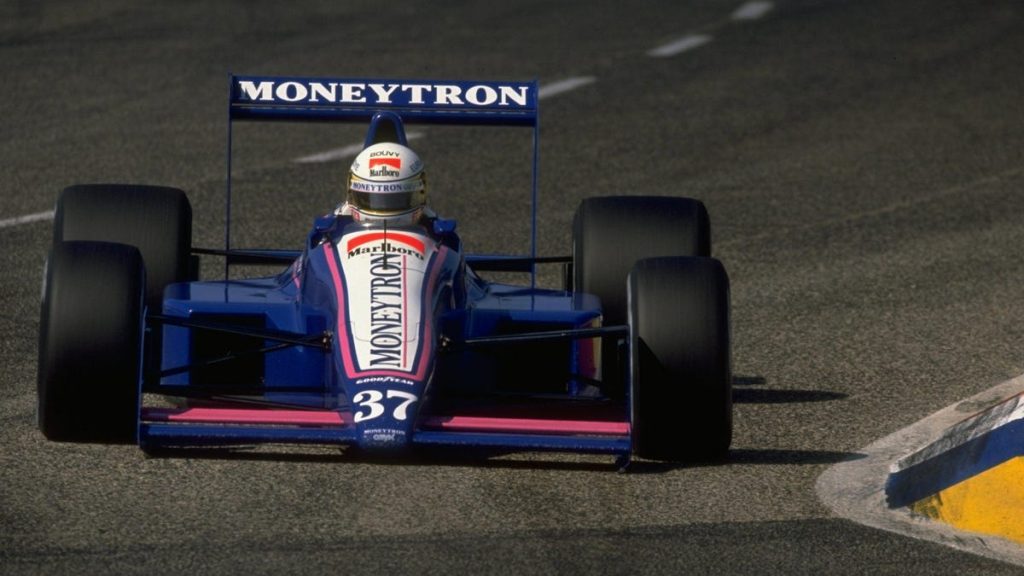How a Fake Machine Said to Predict the Stock Market Became a Formula 1 Sponsor

Bertrand Gachot drives the No. 37 Moneytron Onyx V8 during the 1989 French Grand Prix.Photo: Pascal Rondeau (Getty Images)
When Jean-Pierre Van Rossem debuted his Moneytron machine, he did so with one massive claim: Here was a supercomputer that could accurately predict the stock market and beat out the capitalist system. Invest your hard-earned dollars in Moneytron, he said, and you’ll become infinitely wealthy. With his Moneytron earnings, Van Rossem became the majority owner of the Onyx Formula 1 team in 1989 — and then things collapsed.
(Editor’s note: This week marks the release of Racing with Rich Energy: How a Rogue Sponsor Took Formula One for a Ride by Elizabeth Blackstock and Alanis King. To celebrate a book that began as a blog on Jalopnik, co-author Blackstock is covering the history of some of F1’s other questionable sponsors. These sponsors are touched on in the book, but not in depth. Racing with Rich Energy is available via McFarland, Amazon, Kindle, and Eurospan for international buyers.)
If Jean-Pierre Van Rossem’s Moneytron machine seemed too good to be true, that’s because it was, and there were plenty of red flags that should have told potential investors that this was the case. As a star economics student at Belgium’s University of Ghent, Van Rossem had already learned how to scam the system by charging other students money to write their dissertations, Moneyweek reports. He was also a self-described Marxist who went on to study market fluctuations under Nobel Prize-winning Lawrence Klein.
Don’t let his economics education fool you; Van Rossem was anything but a staid financier. Instead, he was the kind of man who established himself in the eyes of the world by publishing a guide to more than 1,000 of Belgium’s brothels (that came with Michelin guide-style rankings for cleanliness, value for money, and more, according to his obituary on Independent), detailing his own sexual preferences in cartoon comic strips, writing novels, selling duplicated stocks, nursing a heroin addiction, and, later, buying his way into an F1 team. He also allegedly built a refrigerated coffin to house his second wife, who is said to have died by suicide after he met another woman, so he could keep her preserved and see her again before he died.
“The spark went out of the idea,” The Times reported, “when someone cut the electricity to the tomb.”
Of course, if his escapades didn’t quite tip you off that here was a man with eclectic tastes, then perhaps his appearance could have given that away:
Jean-Pierre Van Rossem en Wilfried Hendrickx van Humo maken ruzie
As you can imagine, no one but Van Rossem actually saw the purported Moneytron machine; it was locked up in a room to which only Van Rossem held the key. But people still trusted this charismatic man, and enough wealthy people handed him their money that, in 1989, he claimed to be managing over $7 billion in assets — including wealth from the Belgian royal family.
With all that money at his disposal, Van Rossem invested first in a Formula 3000 team, then brought his sponsorship to the ranks of Formula 1 with the Onyx team for the 1989 season thanks to driver Bertrand Gachot.
Prior to the Moneytron funding, Onyx was fairly successful in the junior F3000 ranks, scoring seven wins in its three-year tenure and finishing second in the 1987 championship standings.
In an Autosport obituary for Van Rossem, Onyx boss Mike Earl said that he was “sad to hear he has died, because without him, we probably wouldn’t have got to F1. He was flamboyant and unpredictable, but without doubt highly intelligent and ultimately a nice guy if you sat down with him away from the limelight.”
After the 1987 F3000 season, Onyx began preparing for its introduction into F1. Paul Shakespeare purchased majority shares in the team in late 1988 to provide it with the money it needed to continue developing a car; sponsorships from Marlboro and Moneytron bolstered the team’s finances.
But being a primary sponsor wasn’t quite good enough for Van Rossem; soon, he purchased Shakespeare’s shares, making him majority owner. With his money came young French driver Bertrand Gachot, who was paired with the dependable veteran Stefan Johansson. By all accounts, Onyx Grand Prix was set to be a hit.
Unfortunately, the car had only just been prepared to ship out for 1989’s season-opening Brazilian Grand Prix, meaning that there was no time for pre-season testing. As a result, the first six races of the season were something of a disaster; between failing to pre-qualify, retirements, and disqualifications, it wasn’t until July’s French Grand Prix that both drivers finished a race, with Johansson scoring points for his fifth-place finish. A podium later in the season in Portugal was the only other high point of the season for the team. It wasn’t exactly a great debut for a brand-new team, but Onyx was confident that, despite a lack of results, it was still making progress.
That is, until Van Rossem started to get really extravagant. Prior to the fourth race of the season in Phoenix, Arizona, Van Rossem purchased a $20 million Gulfstream IV business jet. Then, five races later, the press was reporting that he was interested in spending $40 million to finance Porsche’s F1 engine project; he then went on Belgian television to say that, if the Porsche deal fell through, he would quit Formula 1 — a sport whose expenses Van Rossem was regularly bemoaning.
Then, Van Rossem made the ultimate faux pas: He criticized Formula 1 management. While Van Rossem claimed that he didn’t actually tell a Belgian newspaper that Bernie Ecclestone was a Mafia boss or that FIA president Jean-Marie Balestre was a Nazi, it was enough for Ecclestone to ban Van Rossem from the F1 paddock.
The team that once seemed so promising began to fall apart as the season came to a close and Van Rossem grew stingier with his financial handouts. Team leaders Mike Earle and Jo Chamberlain both quit the team, and Van Rossem, unable to secure an engine deal with Porsche or Honda, backed out of the sport ahead of the 1990 season.
Without their rich benefactor, Onyx began to fall apart. Half of the team was purchased by former racer Peter Moteverdi, with Karl Foitek and Brune Frei equally splitting the other half. The new owners began the slow task of repaying bills from the previous season in order to acquire things like tires for 1990. Not much money was put toward actually developing the car.
But things continued to fall apart. Onyx hired Foitek’s son Gregor as a driver to replace Stefan Johansson after two races; in the opening round, Johansson destroyed two chassis, and after his replacement, he sued Onyx for breach of contract. Amid rumors of broken parts, poor management, and a lack of funds, Onyx folded after the 10th race of the season, the Hungarian Grand Prix.
After selling off his shares, Van Rossem disappeared back to Belgium, where he was jailed for fraud after a $50 million check bounced. He was sentenced to five years in prison, noting at the sentencing that, “The good news is that there will be one capitalist less in the world, the bad news is that he is me.”
However, after serving only a year in jail, Belgian Parliament delayed his sentence because, incredibly, Van Rossem had founded his own political party (the Radical Transformers and Social Fighters for a More Honest Society; in Flemish, that acronym reads ROSSEM) and managed to get elected to Parliament. The country allowed for parliamentary immunity, so Van Rossem was allowed to run free.
Knowing a prison sentence faced him after he finished his tenure as head of his libertarian protest party, Van Rossem published his brothel guide and interrupted his oath-taking parliament ceremony by shouting, “Long live the Republic of Europe,” an anti-monarchy cry directed at Belgium’s King Albert II.
Van Rossem ultimately returned to prison, serving time for charges of forgery, money laundering, tax evasion, and fraud. Inside, he wrote his autobiography and continued on as one of Belgium’s most noteworthy personalities until his death in 2018 at age 73.
Despite barely making it a year in Formula 1, Jean-Pierre Van Rossem created a ripple effect that both made and destroyed the Onyx Grand Prix team. The promise that the team showed in 1989 was effectively scrubbed out thanks to the benefactor that got it to F1 in the first place, leaving the team and its passionate board of motorsport enthusiasts frustrated, broke, and disenchanted. With nothing worth selling, the once-promising Onyx died a frankly embarrassing death while Van Rossem continued to live a rich — and ridiculous — life.







